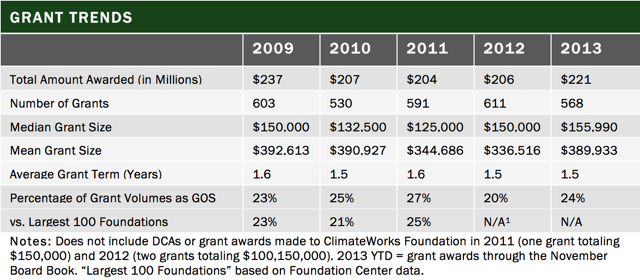Every November, the Board of the Hewlett Foundation authorizes a budget for the upcoming year, and, as part of that process, reviews what progress we have (or have not) made in our grantmaking strategies during the preceding year. As this requires Board members to absorb a great deal of complex detail, last November we rolled out a new version of the Board Book, designed to make the material easier to follow. (June Wang wrote a post about the Board Book redesign for our blog.) The revised Book included, among other things, a new “overview” that presented data for the past five years on the number of grants, their average size and duration, and the percentage that were for general operating support (GOS). Here is what the Board saw:
These figures raised questions for a number of Board members, who found them surprising in certain respects. Several asked whether our grants had become smaller in amount and/or shorter in duration than they used to be. Others wondered if we were drifting away from the Hewlett Foundation’s longstanding preference for GOS. Still others remarked that it was hard to draw conclusions without seeing the data broken down by program. They asked for a more thorough analysis of our grant trends.
The Board’s reaction stimulated a robust conversation among the staff. Had our grantmaking changed in ways that ought to concern us? Have our grants become smaller or shorter or both? Have we moved away from the tradition of helping institutions through general operating support toward a more controlling emphasis on discrete projects? If so, have these changes affected our staffing or the way we work?
Answering questions like these, we soon discovered, is anything but straightforward. On the contrary, our efforts to do so simply raised more questions. For example, the data we used in November presented GOS in terms of the number of grants, which can be misleading because GOS grants tend to be larger and therefore made to relatively fewer organizations. Would it be more accurate to measure GOS as a percentage of grant dollars? Should the data include Organizational Effectiveness grants, which have become numerous in recent years as part of a concerted effort to help grantees, but are—by definition—small and for a single year? How should we classify something like the extraordinary $500 million ClimateWorks grant, which was GOS and paid out over five years, but booked entirely in the year it was made (thus overstating GOS for that year and understating it for the following four)? Similar complications presented themselves when we focused on other measures, like grant size or duration. Even veteran program staff were surprised by the number of potential variations and complications that emerged in our conversations.
We concluded that a more thorough analysis of our grant trends was called for. To that end, we enlarged our review to cover the past ten years, instead of five. Beginning in 2004 made good sense: by then the Foundation’s endowment had recovered from the bursting tech bubble and incorporated the assets of Bill Hewlett’s estate, the administrative structure necessary for a professional foundation had largely been built, and the first stabs were being made to formulate and implement Hewlett’s distinctive brand of “outcome-focused grantmaking.” In addition to making it a ten-year review, we asked the programs to make separate presentations to explain how and why their grantmaking evolved as it did, incorporating a narrative alongside the statistics. We gave each program thirty minutes with the Board at our July meeting, during which they walked through the past decade of grantmaking and described the kinds of things that had shaped their particular outcomes. The memos they prepared for this purpose are included in my annual letter for 2014.
My task, at the conclusion of these presentations—which we interspersed with other business over the two-day meeting—was to draw things together and make some sense of the overall picture that emerged, if one emerged. (It did.)
My full letter shares what we found. I hope you’ll take the time to read the whole thing.

